|
Sunday, Jan. 6 / 7 - Fly to Singapore
Long day - left the house at 7:40am and drove to LAX. Got to the airport about 10 - over 3 hours before our departure time. 3 hours was barely enough time to check in, cart our luggage to a special X-ray machine, wait to make sure the luggage was carted back to Singapore Air, and go through the long security lines. The airport was packed and Singapore Flight 11 was also packed. At 1 pm, we settled into our seats and went into auto pilot mode. The Japanese fellow in the seat ahead of me was an Elvis look-alike - white jump suit, long silk scarf, wearing dark glasses and a fake pompadour wig. He was entertaining to me until he reclined his seat back resting in my lap - Even the real Elvis would have irritated me with that rude behavior.
The plane food was pretty good and there was lots of it. They served Ben and Jerry's Chocolate Brownie Fudge ice cream for dessert - now that was the kindest thing anyone has ever done for me on an airplane.
We arrived in Tokyo in the middle of the night and de-planed for an hour. It took us that long just to go back through security. The next leg of our journey was 7 hours to Singapore - the worst was over. In our zombie-like condition, we watched more movies, took more cat naps, and ate more food (vanilla ice cream for dessert this time). We finally landed in Singapore about 1:45 am. We lost a day somewhere over the Pacific. We only had a few more housekeeping hassles between us and a hotel bed -- clear customs, gather luggage, pick up our coupons from the package we booked with Singapore Stopover Holiday and find the mini-van bound for our hotel. We arrived at our hotel at 3 o'clock in the morning and were in bed by 4. The hotel (Furama Riverfront) is nice. The cute little gal at the desk, feeling sorry for us beleaguered travelers, gave us an upgrade to the 11th floor. We scored with a wonderful, big, quiet room in a classy old hotel. After being in transit for almost 30 hours, we were delighted to be prone in our big ole bed. Let the adventure begin
Tuesday, Jan. 8 - Singapore
We woke up about 8, showered and went down to breakfast at 9. The breakfast buffet was OK. Up to our usual tricks, we pilfered extra bread, ham and cheese and made sandwiches, wrapped them in our napkins and stuffed them our the backpacks for lunch.
We studied the maps, the brochures, and talked to the happy Singapore Stopover Holiday representative with endorphins working overtime. She pumped us up and then we hit the streets in comfortable walking shoes.
It is very hot and humid - I had forgotten about life in the tropics - the rumbling sky felt like it would release a downpour at any minute.
From 2000, I remembered the squeaky clean city and the lovely well-manicured gardens - not much has changed. We headed east toward Chinatown. Our first stop was the Chinatown Heritage Centre (48 Pagoda Street) tucked away in a typical Chinatown pedestrian mall. The building, once three tailor shops, is now a simple, nicely done museum with the focus on the Chinese immigrant. It was much like us Americans visiting Ellis Island. The museum was dark, giving the feel of living in cramped living quarters with hopeless dreary lives. Water was delivered by cart and excrement was picked up in pots, which the pick up services often spilled on the floors. The Chinese came to Singapore during the late 1800's to the early 1920's, out of desperation. They arrived hoping to make some money to send back home and then return to China. In Singapore, they found only low level manual jobs - coolies, miners, factory workers, and other backbreaking occupations. Later they became tailors, merchants and trades people. We learned that associations were formed to help the new immigrants. We also learned about the dangerous secret associations (like gangs and the mafia, operating outside the British law) made life even tougher on the immigrant. Because of these conditions, many turned to opium (first considered "good" and encouraged by the government - economically beneficial for their trading policies. A couple of other big hitting vices to distract the lonesome, beaten down immigrant were gambling and ladies of the night. Classy young beautiful Chinese girls became "song girls" and were paid well to accompany wealthy businessmen on "dates."
I was feeling despair for the plight of the Chinese immigrant. However, the last few rooms of the museum told several happy stories of the present and future. (It's a common theme in museums - Singapore plays it up big time.)
Knowing all is well with the Chinese and their descendents, we ventured on down the road to Temple Mariamman to check in on the Hindus. We had visited the temple seven years ago with Bob and Madeleine. Not much has changed. However, some of the colorful statues looked a little faded. There was lots of activity in the old temple - handsome young shirtless bronze Indian men were feeding the crowds rice balls served on pieces of paper. I paid $3 to take some photos and then we ate our pilfered lunch among the locals. A friendly local sitting next to us told us he was 78 years old. He looked great - full head of hair and trim body. We carried on how good he looked, then he said he came here to pray because he has a terrible disease and probably not much time left. The good news is that he's a retired teacher and has medical coverage.
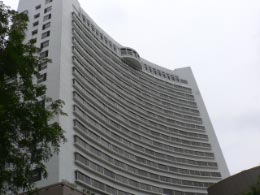
Our Hotel in Singapore--Furama Riverfront |
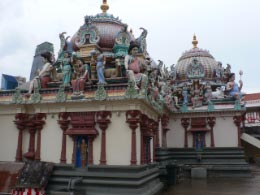
Temple Mariamman |
After lunch we walked further north and into the old colonial section along the Singapore River. I loved the walk by the riverfront - so clean and civilized. Just when everything seemed normal I spotted a man walking his snake right by the statue of Sir Stamford Raffles, the town founder. Always something fascinating to get one's attention.
We got to the Asian Civilizations Museum (1 Empress Place) just in time for the 2 pm guided tour. (Admission $10 / $5 for seniors - that would be us!) The museum was built during the time of Queen Victoria (and hence named Empress Place). It was a grand old building and once housed almost the entire government bureaucracy around 1905 and remained a government office until the 1980's.
Nikky, our English tour guide, was very knowledgeable - We learned a lot from her that afternoon. She showed us a 2500 year old bronze drum (with elaborate symbols of rain etched on it's surface) found in some rich guy's grave. Bronze was the new hot item back then. Then Nikky showed us a room devoted to the headhunters. The things reminded me of our Borneo adventure and the Dayak (sea gypsy) tribe. On to the Islamic section, Nikky told us about Mohammed and showed us some of the early Korans. The guys who made copies of the Koran were hand picked and spent years as apprentices. Part of their training was to carve their own writing instruments out of reed. They believed their soul was in the reed. We saw several similar Korans in museums in Turkey. Nikky reviewed the 5 pillars of the Islamic faith - pray 5 times a day facing Mecca, visit Mecca once (if you have the money), only one God and Mohammed is the last prophet, give alms to the poor (2% of your money), and fast during Ramadan. The museum displayed geometric shapes or floral shapes taken from mosques. It's a sin to depict the human figure or any other living thing.
After Nikky finished her spiel on Mohammed, she dived right into Buddha. Buddha was a prince of a guy who came from a royal family in Nepal living at the base of the Himalayas. The story goes that his mother was a virgin when she discovered she was pregnant with him. She carried him 10 months and delivered him painlessly through her side. He was able to walk as soon as he was born. Buddha had a cushy life in the palace - never knowing pain or suffering. Then at 29, he saw someone sick and dying and decided to leave the good life (and a wife and kid in the palace) to find enlightenment - which he did right under a cool tree (can't remember the name of the tree). Nikky pointed out symbols of Buddha in several of the amazing ancient pieces - serpent throne, lotus flower (grows from mud into a beautiful flower), the tree where Buddha got it, and the knot on the top of his head (symbolizing enlightenment).
The special exhibit, "On the Nalanda Trail" focused on the spread of Buddhism in India, China and Southeast Asia. Nalanda was one of the world's first great universities. Established in the 5th century, many masters of Buddhism taught there. Nalanda University was going strong for over 700 years and at it's peak, there were over 10,000 students and 2,000 teachers. One of the professors who taught at Nalanda for a couple of years was a Chinese monk. He was famous because he left China and traveled the silk road for over 17 years spreading the word of Buddha and gathering treasures. The monk also kept journals describing life on the silk road. Scholars are crazy about his journals today. (Wonder if any one in future will care about my travel journals.) On display were drawings, paintings and small clay figures from the silk road travelers. My favorite was a comical drawing of a caravan with funny characters lined up with their camels and horses. One of the camels was irritated because a fly landed on his nose. (We first learned about caravan-life and caravansaries in Turkey so the exhibits were all the more precious.) Nikky ended her tour by showing us a 6 inch pyramid placed on a tall gold-plated throne that she swore contained some actual ashes of Buddha. We learned lots of "OH WOW" stuff from Nikky. Bill and I tried to absorb the rest of the museum on our own -- but we were overwhelmed. It was one of the best museums I've seen - but impossible to take it in just a few hours. We left with exploding brains.
A heavy rain hit while we were in the museum and lingered a bit while we walked up the road to St. Andrew's Cathedral. It was just a so-so cathedral, built in 1856 to replace the original church that was destroyed in 1852 by lightening. St. Andrew's was a bit worn - and Bill and I were a bit worn out so we decided to head on down to the famous old Raffles Hotel for a Tiger beer. However, there was some confusion on the way -- confusion that leads to irritation. To top it off, when we got to the Raffles Hotel, we discovered happy hour beer was $13 - forget it. The classy old Long Bar I remembered seven years ago was now just loud and filled with obnoxious music and drunk, young rich people. The outdoor veranda was also noisy and hot. We nixed the plan, regrouped and headed out to another place.
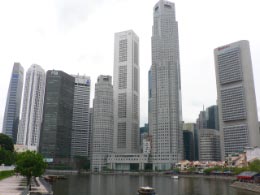
Singapore's Modern Skyline |
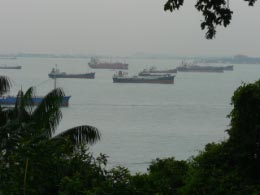
Southeast Asia's Busiest Ports |
We looked for the recommended "hawker's court" - plain, simple food served up in food-court fashion where the owners "hawk" their wares. Plan B also had its problems when we couldn't find the recommended spot. Worn down, we stopped in an air-conditioned mall at a food court (Asian Kitchen) for some simple fried rice and a beer. It was good to take a break, but the simple dinner and beer at the food court was over $25 - We'll do better tomorrow.
We finished our day around 6 p.m. and discovered the free hop-on bus service stopped running at 5:40, so we had another long hike back to the hotel. After walking at least 10 miles, we got back to the room at 7:30 - tired from a long, but fascinating day.
Wednesday, Jan. 9 - Singapore
I woke up about 3:30 and couldn't get back to sleep, so finally at 5:00, I got up to do some yoga to get the chi (energy) flowing. We had breakfast at 7 and were ready for another full day by 8.
We grabbed a cab to Sentosa Island ($12) just 15 minutes away. Sentosa is an idyllic, green, lush place set aside for recreation. (There is admission to the island and free shuttle buses to explore the place.) It's a feel-good place where folks flock to the fancy resorts, the beaches, the golf courses, the flashy Disneyland adventures or the museums to learn more about Singapore. Never saw anything quite like it before.
We passed on Underwater world and some other tacky attractions. We hiked up the Twin Dragon trail in the once authentic rainforest. We wondered if the bird sounds were pumped in. The tall canopy of trees covered in ferns and moss were definitely real. Later, we saw a large monitor lizard cross the road in front of the shuttle bus.
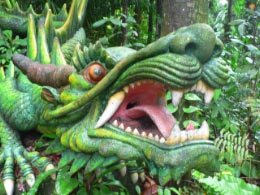
Twin Dragon Trail |
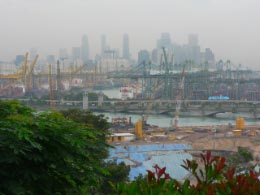
Singapore from Sentosa Island |
The hike took us to Island central (Imbiah Mountain) where this 4 or 5 story part lion, part sea creature called Merlion greets you. We missed the fountain spewing from his mouth - but had seen enough.
Images of Singapore
According to the guide books, the main reason for coming to Sentosa Island is to see the Images of Singapore housed in a huge museum. This was multi-media / dioramas at it's best. Through video, 3-D actors, walk-through villages, wax figures (some were robots that talked - really spooky stuff), we learned about Singapore.
Singapore is called "The Land below the Wind." The monsoon rains drove trading ships down to Singapore where they did their trading and then were stuck from 6 to 9 months waiting for the heavy rains to pass. They couldn't return north against such a strong current, so they put down some roots, bringing their culture, building their temporary "home away from home" and basically, merging with other traders also stuck on the island. (NOTE: Later, the steamship changed all that because they could leave anytime with their powerful engines - but the mixture of cultures had been established.)
The museum first hit you with a wowie-zowie, no-dry-eye-in-the-house, short introductory video. Four main characters become 3-D images, ghostly images on a stage. One Indian, one Chinese, one Malay, and one European all talked about their simplistic dreams for Singapore. Their dreams of family, peace, love, happiness, etc. became floating circles that embraced the audience. After the 5-minute warm and fuzzy show, the doors opened to a variety of different displays that went on and on.
Some of the exhibits were brilliant and powerful images while others were just plain silly. We walked through Stamford Raffles signing papers in 1819 to take over Singapore for the British. (The truth of the matter is that the Brits didn't have a clue what cunning Raffles was up to and later reprimanded him for not following orders. That was not part of the exhibit.) We walked through scenes from the little Malay fishing village (that would later become Singapore, scenes from early Chinatown, scenes from Chinese celebrations, scenes from the smelly, busy wharf, scenes from Malay weddings and so on. The scenes were sprinkled with lots of wax figures - some automated, some not and even some real people pretending to be wax figures. I climbed up into a rickshaw so Bill could take my picture. When the cooley driver posing as a mannequin moved, I screamed and then we all had a good laugh.
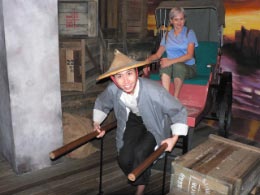
Images of Singapore |
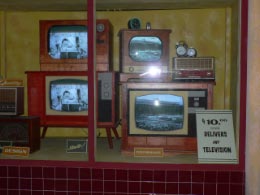
Images of Singapore |
The war scenes were powerful with videos of the Japanese attaching Singapore and the rumble and death they left behind. Walking through the room of soldiers hiding in the jungle was eerie (although the dummies, fear stricken and drenched in red paint for blood, could not have come close to the terror the soldiers must have felt).
Later on, down the timeline (1950's / 60's), was sending the British home leaving Singapore to self-govern. I loved how the video of the British leaving was played on old TV sets in a television store. I also liked how the video was used with old family photos.
The last room (Singapore Celebrates) really put me over the edge with flowers and sunshine and happiness. It was another upbeat "future is bright" to leave you hopeful and smiling. (Didn't work on this cynic.) The intent was to recognize the blending of cultures showing the festivals and traditions of the Chinese, Malay, Indian and Peranakan cultures. The museum design committee assigned to creating that ending section really blew it. In spite of the final silliness, we came away with a much better understanding of Singapore.
A Note of Apology:
On second thought, Singapore did come up roses and deserves those "big-pats-on-the-back" exhibits. Singapore has come a long, long way in just over 60 years, considering the Japanese bombed the smithereens out of the place in 1942, occupied it for 3 years and left it in shambles. Then the poor little country struggled to get rid of the Brits and find it's own way. Now I see a world class country - not a trace of third world here. There are amazing buildings, an out-of-this-world airport, shopping centers that boggle the mind, a transportation system that moves millions of people efficiently plus it's scrubbed and safe. People embrace their diversity. This is truly a lovely place.
We took the free shuttle bus to Fort Siloso for our next adventure on Sentosa Island. We found a picnic table to eat our sandwiches. I was stalked by the most aggressive peacock -- chased me all around the table, but left Bill alone.
Fort Siloso
The British coastal Fort Siloso, over a hundred years old, is set high up on a hill on Sentosa island. It was established in the 1880's as a result of the opening of the Suez Canal. The once sleepy port town was now loaded with traffic making Singapore strategically critical in the British Empire.
With fabulous views overlooking Singapore harbor, the old fort is beautifully restored to it's former glory days (and days not so glorious). We walked all over the place with soundtracks of explosions, soldiers talking and firing canons. We saw the soldier dummies performing their duties, but, rather than being hokey, they added much to the exhibits.
We visited the oldest part where the volunteer army practiced firing only one canon ball per week. We saw the old 1880's barracks, disgusting cook house and laundry room, tailor shop and troop ship bunks. (Young British soldiers were shipped off to Singapore for their 3-year duty.)
We went through tunnels, explored guard houses and places where the big guns and ammunitions were stored.
Singapore managed to avoid any combat in WWI and expected to avoid any trouble in WWII. The fort's most poignant and sobering exhibits were about WWII. The films from the fall of Singapore were tough to take. If ever there was an axis of evil, it surely was the Japanese. Singapore expected the Japanese to attack from the waterfront, but instead the Japanese came down through Thailand. Thailand, trying to save its own neck, cut a deal with the Japanese and turned it's back on it's neighbors and peninsular Malaysia. Nobody expected Japan's army of 35,000 to advance on foot through 400 miles of tropical jungle in just 30 days. The Japanese arrived on land from behind (not from sea) and caught the Singapore soldiers with their pants down. The Japanese defeated an army of 90,000 in a month and demanded complete surrender. For three long years the invaders made life a living hell for all those in the way. They took over big time - setting up their Japanese government and way of life, changing the education system, the currency, the language, the postage, and even re-named Singapore Syonan-to . They were most brutal to the Chinese and of course, the POW's. (On display were drawings done by some of the POW's so no one would forget.) Finally, in September of 1945, the Japanese were defeated.
The last building we visited was the surrender room (the actual room) where British General Percival and his entourage signed over Singapore (with no negotiations) to Japan. Wax figures depicting the leaders from both sides with the actual footage of the signing playing in the background. The surrender of the Japanese was depicted In the adjacent room. You could just feel the emotions of those guys that squared off behind those old wooden tables.
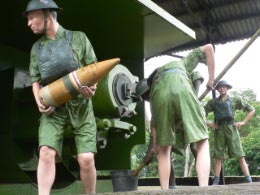
Fort Siloso |
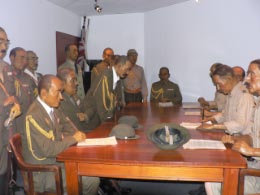
Fort Siloso--British Surrender |
At the end of our tour of the fort, the sky opened up, as it does in a tropical rainforest, and treated us to an amazing downpour. I understand why things are so very green here. We shared a Magnum ice cream under an awning while we waited for our bus, which took us to the monorail station. One scenic hop over a massive construction project below (much bigger than ground zero) and we were back in Singapore. We were amazed by our bird's eye view of the construction site. The heavy equipment was bogged down in 5 feet of water, but the work went on. A little flood here and there is nothing to these guys.
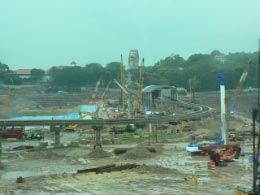
Slushy Construction Site |
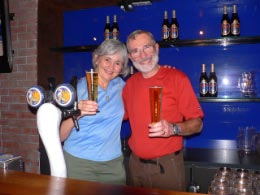
Tiger Live |
The Monorail delivered us to Harbor Center - a monstrous modern mall. Singapore has so many of these mega, mega malls loaded with shoppers. Seemed like half the mall was dedicated to electronic stuff and other gadgets. There were also store after store devoted to beauty products and unknown procedures. Take a number, get your shot of Botox. I had no idea of the massive beauty / spa market - I need to get out a little more.
Tiger Live Experience
Our next destination was a Tiger Beer. As part of our travel package, we had free admission ($21 for those without a coupon) to a place called "The Tiger Live Experience" - a flashy show designed to promo Tiger beer. Free Tiger beers (and Tiger beer glasses) came with the show. (In 2005, we shared a similar Heineken experience with our friends, Steve and Daira, while visiting in Amsterdam - so we had an idea what we were in for.) The place, established about a year ago, is located in an old Power Station. We crossed a covered bridge walkway from the mega mall overlooking the massive docks and ships and shipping containers and found our way to the old power station now transformed into a "Tiger Life" mecca.
We were the only guests - alone in this strange land with a dozen or so perky employees on walkie talkies coordinating our way through the massive, bizarre exhibits. Our cute guide first told us about the history of Tiger Beer, the brewing process and led us through the 9 massive night clubs (closed and empty now, but hopping in the wee hours of the morning). The clubs were not appealing to us at all - even the one targeted for old folks like us - The Cuban Club.
Tiger Beer was started in the 1930's to bring industry to Singapore during the depression. A couple of guys who made soda drinks back then (F & N) formed a joint venture with Heineken beer in Amsterdam. They came up with the name "TIGER" because the letters between the T and R were powerful symbols -
"i" represented the number 1
"g" looked like an eight (lucky number)
"e" is the same font used in Heineken logo.
Something worked because the factory has been through-the-roof successful since it's opening.
Next we donned a pair of 3-D glasses, climbed up on a huge rotating theatre and were treated to a most bizarre five minute video. Big as life, before our eyes, we watched two cartoon-type hops (the kind used to make beer) falling in love, becoming beautiful sexy golden creatures (without a bottom half), swirling, making love as they became part of the Tiger brew. The elaborate theatre rotated around, shot air at you and blew bubbles from overhead to add to the drama. What kind of mind came up with that concept? (We were also treated to other strange videos of Tiger employees - early employees thinking of ways to steal the beer because they produced so much, a pregnant employee telling how good beer is for the baby, on so on - Mind boggling.)
Finally, we were lead to the bar to sample a glass of Tiger Beer. Our cute little guide showed off their US$20,000 beer pump that keeps the beer at 2 degrees C. She kept stroking the ice that formed around the phallic pump and then she lead us behind the bar and showed us how to pump our own beers. Those really cold ones hit the spot. Steve and Daira would have loved the silliness - We thought about our absent travel buddies as we sipped our brew. (Steve and Daira -- If you're reading this, prepare yourself for one tacky souvenir we got you from our Tiger Experience. Miss you guys.)
We left the old Power Station and walked along another covered bridge to an official "hawker's food court" and picked out a stall populated with hungry eaters. We also picked a stall with food we could recognize. Bill got the sweet and sour chicken - which was very spicy and I got a fried rice dish - both for $3 each.
We walked back along the covered bridges to the MRT and took the underground back to our hotel. We still had a ½ mile or so to walk before we got to our hotel. Dark threatening clouds filled the sky again. Luckily we got back before the next deluge.
We turned on CNN to learn that Hillary won the New Hampshire primary - 39% to Obama's 37% while McCain was the Republican winner. We also watched Bush deplane in Israel - Oh please don't let anyone assassinate him. They can take Cheney, just get us through this year and send Bush safely back to the ranch.
Bill did the laundry while I pounded out the journal on our new laptop. What a day! Hope we can keep up this crazy pace!
Thursday, Jan. 10 - Singapore
Our goal for today was the National Museum, the Zoo and the Night Zoo. We had our breakfast and walked a couple of miles to the National Museum. We got there just at opening time.
The National Museum
The National Museum of Singapore, only a couple of years old, was very impressive. I loved the huge open foyer that spanned 4 stories - very simple and blocky with ten or so red gaudy chandeliers swinging at random intervals. On the basement level, massive gothic pillars melted into the floor - very quirky and clever.
We started in the Living History section. The audio guide leads you through the latest in museum technology. Video that bowled you over was projected on a semi-circle screen surrounding you with images of the early history. After the video, we had our choice of taking the "events" path (to learn facts) or the "personal story paths" (to hear the stories from the ordinary people). We chose the "events" path. It took us a couple of hours - such wonderful displays and artifacts. The sections went on and on filling you in with details of Stamford Raffles, his wife and his ploy to make Singapore a major trading area. We went from section to section learning about the arrogant ruling British, the down-trodden immigrants (Chinese and Indian), WWII and the fall of Singapore, the Japanese cruel occupation (1942), then liberation (1945), then shambles, then kicking the British out and establishing independent Singapore some time in the 1960's. Of course, the exhibit ended with "the future is bright" - and it is.
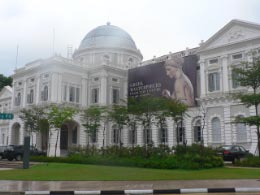
National Museum |
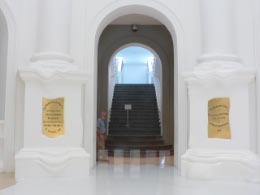 National Museum--Melting Display
|
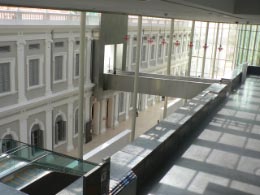
National Museum--Foyer |
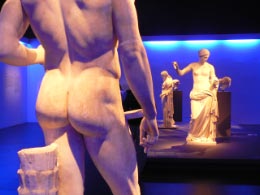 National Museum--Greek Statues
|
We took a museum break and ate our sandwiches on the lawn outside and then headed back to do the rest of the exhibits. We quickly covered four eye popping galleries - Fashion, Food, Film and Photos. The Food galleries beautifully displayed spices in jars with gizmos to get a whiff of the smells - very clever. The Photo gallery not only displayed lots of photos, but also videos to add meaning to the pictures - a Chinese prostitute sending the photo back to her brother in China, a wealthy British kid with photos of his nanny, a proper British woman and her Chinese husband. (She organized a club -- support group -- of women like herself in a mixed race marriage.) The film and fashion gallery were also beautifully done. We had one more gallery to cover - a special exhibit of Greek culture straight from the Louvre in Paris. The rooms of stark white marble statues displayed accented with glowing neon lights made for a way cool exhibit. The information was great - but now it was difficult for us to pack more facts into our over-stimulated brains.
We called it quits at the museum about 2 pm. (We'd been there since 10.) Just as we headed out the door, the sky opened up turning the heavenly facets on full force. We went back into the museum to have a beer and wait for the storm to pass. We nestled into some comfortable artsy-fartsy bean bag chairs tucked away on the main floor of the foyer. We drank our beers looking up at the glass ceiling 4 stories overhead watching buckets of rain running down the sides of the glass building. Blowing wind, thunder and lightening added to the drama. It was lovely until the check arrived and we learned we had just paid US$25 for a couple of cold ones. The beer had numbed us and the rain had calmed us so we just kicked back and took a little snooze - $25 well spent.
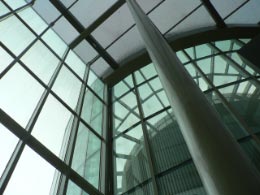
National Museum |
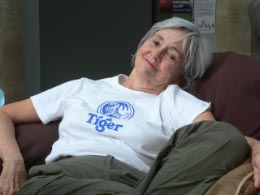
Nancy Relaxing at Museum |
An hour later, the storm had passed and we hoofed it down to the nearest MRT (underground) station. For just $1.50 we traveled many miles northwest to another mega mall / transportation hub and caught a city bus to the zoo for another buck. In the rain, the bus drove through urban areas and rainforests and finally arrived at the zoo about 5 pm. Lucky for us the rain subsided just as we were arriving. The zoo closed at 6:30, but we didn't mind having just an hour and a half to nose around because we had free admission with our travel package.
I had low expectations for the Singapore Zoo because the world famous San Diego Zoo is in our backyard - boy was I mistaken. Set in a wonderful lush rainforest, the winding paths led us to three white tigers, a troop of baboons, orangutans, howling lemurs and other critters. I had only seen one white tiger in a cage in Las Vegas years ago. I vaguely remember the little fella, but these white tigers were grand and powerful. One even posed for me. The orangutans are always fascinating, but we were jaded by seeing wild ones in Borneo - just not the same when you know they won't be climbing down off their trees and joining you on the walkway. We finished our zoo experience right at closing time and grabbed a fast food pizza with a Ben and Jerry chaser.
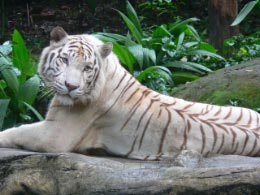
White Tiger at Singapore Zoo |
We walked down to the Night Safari which opens at 7:30 pm. It's a completely different facility right next door to the Zoo. Someone had a brilliant idea - show off the nocturnal animals while remaining open in the evening when the tropical heat subsides a bit. The Night Safari is a new thing in Singapore and wildly successful. The place was packed. The layout and design was wonderful - the open air village and the dramatic light highlighting the mangrove forest. My favorite place was, of all places, the woman's bathroom. The walls are black with eyes painted on them. Only the stall doors and basins are white. Behind each stall is a poster of an animal taking a whiz. I sat down to do my business and starring at me was a poster of a jackal lifting his leg. I dashed from stall to stall to see the other posters - hyenas, gazelles, elephants, and so on all marking their territory I knew Bill was waiting outside so I quickly completed my tour of the ladies room.
We headed to the "Animals of the Night" show hosted by beautiful Indian gal (from India). She was charismatic, electric and a total enigma. With a jeweled forehead and dressed in a typical beige zoo keeper's outfit, she was a cheerleader and a comedian. She introduced her animals friends one by one - a python, a wolf, otters, an owl, and a couple of raccoon brothers. I probably won't remember much about the animals, but I'll never forgot her.
After the show we boarded the tram. We passed by lots of active animals with great staged lighting - saw a tiger, giraffe, rhinos, and lots of hoofed animals to name a few. We passed by a tapir so close you could reach out and pet it - if you weren't afraid of being bitten. There was a noisy group on the tram so we disembarked to take a hike and returned for the second part of the tram ride later.
We took several trails - It was magical in the dark rainforest with spotlights shining on the wet leaves and sounds of animals all around. We saw flying foxes and squirrels (who were really flying) and a cheetah, but the best was a tiger. Just as we approached the glass, a huge tiger emerged from the dark to stop and stare at us. I quietly willed it to come closer to the glass. It then looked up and charged at me. I was scared, but relished in my new found powers of the mind. Then I discovered it didn't come to me. It was after a couple of cornish hens the zookeeper from up above tossed on the ground right in front of us. The tiger devoured the hens only a few inches away from me, stopping a few times to growl at me. Now that's exciting.
By 10 pm, we had had enough excitement and needed to make our long journey back to the hotel. Right outside the gate, the proper looking tourists climbed aboard fancy double decker buses to take then directly to their hotel in comfort. We waited for the city bus and joined the huddled masses - students, young lovers and some elderly. We arrived back at the mega-mall and then found the subway. After one ride, we transferred to another line. We arrived at our destination, but still had a ½-mile walk back to our hotel. It was about 11:30 pm and the neighborhood was hopping. The local restaurants were packed. "Ladies of the night" in their high heeled shoes and mini skirts were strutting their goods while talking on their cell phones making business arrangements.
I was glad to get back to our room - what a full day - left our room at 9:30a.m. and didn't get back until almost midnight. We were bushed.
|











